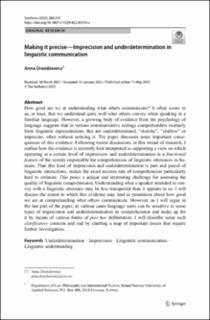| dc.description.abstract | How good are we at understanding what others communicate? It often seems to us, at least, that we understand quite well what others convey when speaking in a familiar language. However, a growing body of evidence from the psychology of language suggests that in various communicative settings comprehends routinely form linguistic representations that are underdetermined, “sketchy”, “shallow” or imprecise, often without noticing it. The paper discusses some important consequences of this evidence. Following recent discussions in this strand of research, I outline how the evidence is currently best interpreted as supporting a view on which operating at a certain level of imprecision and underdetermination is a functional feature of the system responsible for comprehension of linguistic utterances in humans. That this kind of imprecision and underdetermination is part and parcel of linguistic interactions, makes the exact success rate of comprehension particularly hard to estimate. This poses a unique and interesting challenge for assessing the quality of linguistic comprehension. Understanding what a speaker intended to convey with a linguistic utterance may be less transparent than it appears to us. I will discuss the extent to which this evidence may lead to pessimism about how good we are at comprehending what others communicate. However, as I will argue in the last part of the paper, in various cases language users can be sensitive to some types of imprecisions and underdetermination in comprehension and make up for it by means of various forms of post hoc deliberation. I will describe some such clarificatory contexts and end by charting a map of important issues that require further investigation. | en_US |

